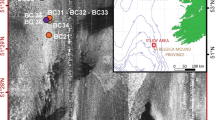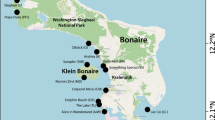Abstract
Benthic Foraminifera found attached to the deep-sea coral Primnoa resedaeformis may be used to establish paleo-coral locations long after the coral has disappeared. Recent coral research cruises have revealed that the coral on the Scotian Margin is in peril and in many cases no longer exists. Sea floor video footage suggests various fishing methods have destroyed much of the coral as it has in coastal areas off Norway and Alaska. To date deep-sea corals are sparse on the Scotian Margin; therefore evidence preserved in the sediment may establish whether corals were present and more abundant in the past. A representative assemblage of benthic foraminiferans found attached to the deep-sea coral Primnoa resedaeformis may be the evidence necessary to provide presence/absence indicators long after the coral has disappeared. Both foraminiferal species are known to be only associated with the coral, and distortion of the ventral side (attached) of common foraminiferal species found in the sediment, may provide a clue to past coral habitat. Identifying a deep-sea coral paleo-habitat indicator provides insight into the extent to which it existed. Video footage from coral cruises over the last three years indicates that coral and fish go hand in hand, an important observation for a region where fishing comprises 23 % of the local economy.
Twenty-eight foraminiferal species were found in a range of abundances on nine deep-sea coral specimens of Primnoa resedaeformis. Attached foraminiferans are found on the basal sections of the coral where they colonize onto the hard calcite substrate. One of the more common and consistent foraminiferal species found attached to the coral, Discanomalina semipunctata, is not found commonly on the continental margin in non-coral areas and may provide in situ evidence of past coral habitat.
Access this chapter
Tax calculation will be finalised at checkout
Purchases are for personal use only
Preview
Unable to display preview. Download preview PDF.
Similar content being viewed by others
References
Breeze H, Derek S, Butler M, Kostylev V (1997) Distribution and status of deep-sea corals off Nova Scotia. Marine Issues Comm Spec Publ 1. Ecology Action Centre, Halifax
Drapeau G (1971) Sedimentology of the surficial sediments of the western portion of the Scotian shelf. PhD thesis, Dalhousie Univ
Drinkwater KF, Mountain DB, Herman A (in press) Variability in the slope water properties off eastern North America and their effects on the adjacent seas. J Geophys Res
Freiwald A, Schönfeld, J (1996) Substrate pitting and boring patterns of Hyrrokkin sarcophaga Cedhagen, 1994 (Foraminifera) in a modern deep-water coral reef mound. Mar Micropaleont 28: 199–207
Gooday AJ (1994) The biology of deep-sea Foraminifera: a review of some advances and their applications in paleoceanography. Palaios 9: 14–31
Haward NJB, Haynes JR (1976) Chlamys opercularis (Linnaeus) as a mobile substrate for Foraminifera. J Foram Res 6: 30–38
Jensen A, Frederiksen R (1992) The fauna associated with the bank-forming deepwater coral Lophelia pertusa (Scleractinia) on the Faroe shelf. Sarsia 77: 53–69
Jones RW (1994) The Challenger Foraminifera. Oxford Univ Press, Oxford, 149 pp
Klitgaard A (1995) The fauna associated with outer shelf and upper slope sponges (Porifera, Demospongiae) at the Faroe Islands, northeastern Atlantic. Sarsia 80: 1–22
Linke P, Lutze GF (1993) Microhabitat preferences of benthic Foraminifera: a static concept or a dynamic adaptation to optimize food acquisition? Mar Micropaleont 20: 215–234
Lohman GP (1978) Abyssal benthonic Foraminifera as hydrographic indicators in the western South Atlantic Ocean. J Foram Res 8: 6–34
Lutze CF, Thiel H (1989) Epibenthic Foraminifera from elevated microhabitats: Cibicides wuellerstorfi and Planulina ariminensis. J Foram Res 19: 153–158
Mackensen A, Sejrup HP, Jansen E (1985) The distribution of living benthic Foraminifera on the continental slope and rise off southwest Norway. Mar Micropaleont 9: 275–306
Medioli FS, Scott DB (1978) Emendation of the genus Discanomalina Asano and its implications on the taxonomy of some of the attached foraminiferal forms. Micropaleont 24: 291–302
Mortensen PB, Buhl-Mortensen L (2004) Distribution of deep-water gorgonian corals in relation to benthic habitat features in the Northeast Channel (Atlantic Canada). Mar Biol 144: 1223–1238
Murray JW (1973) Distribution and Ecology of living benthic Foraminiferids. Heinemann, London
Murray JW (1991) Ecology and palaeoecology of benthic Foraminifera. Longman, London
Pershing AJ (2001) Response of large marine ecosystems to climate variability: patterns, processes, concepts, and methods. PhD thesis, Cornell Univ
Petrie B, Drinkwater K, Gregory D, Pettipas R and Sandstrom A (1996) Temperature and salinity atlas for the Scotian Shelf and Gulf of Maine. Canad Tech Rep Fish Aquat Sci 171, 398 pp
Schönfeld J (1997) The impact of the Mediterranean Outflow Water (MOW) on benthic foraminiferal assemblages and surface sediments at the southern Portuguese continental margin. Mar Micropaleont 29: 211–236
Schönfeld J (2002) A new benthic foraminiferal proxy for near-bottom current velocities in the Gulf of Cadiz, northeastern Atlantic Ocean. Deep-Sea Res I 49: 1853–1875
Scott DB, Mudie PJ, Vilks G, Younger DC (1984) Latest Pleistocene-Holocene paleoceanography trends on the continental margin of eastern Canada: foraminiferal, dinoflagellate and pollen evidence. Mar Micropaleont 9: 181–218
Scott DB, Baki V, Younger CD (1989) Late Pleistocene-Holocene paleoceanographic changes on the eastern Canadian margin: stable isotopic evidence. Paleogeogr Paleoclimatol Paleoecol 74: 279–295
Semeniuk TA (2000) Spatial variability in epiphytic Foraminifera from micro-to regional scale. J Foram Res 30: 99–109
Sherwood OA, Heikoop JM, Sinclair DJ, Scott DB, Risk MJ, Shearer C, Azetsu-Scott K (2005) Skeletal Mg/Ca in Primnoa resedaeformis: relationship to temperature. In: Freiwald A, Roberts JM (eds) Cold-water Corals and Ecosystems. Springer, Berlin Heidelberg, pp 1061–1079
Shore JA, Hannah CG, Loder JW (2000) Drift pathways on the western Scotian Shelf and its environs. Canad J Fish Aquat Sci 57: 2488–2505
Streeter SS (1973) Bottom water and benthonic Foraminifera in the North Atlantic Glacial-Interglacial contrast. Quatern Res 3: 131–141
Streeter SS, Lavery SA (1982) Holocene and latest glacial benthic Foraminifera from the slope and rise off eastern North America. Geol Soc Amer Bull 93: 190–199
Thomas FC, Medioli FS, Scott DB (1990) Holocene and latest Wisconsinan benthic foraminiferal assemblages and paleocirculation history, lower Scotian Slope and Rise. J Foram Res 20: 212–245
Williamson MA (1983) Benthic foraminiferal assemblages on the continental margin off Nova Scotia: a multivariate analysis. PhD thesis, Dalhousie Univ
Williamson MA, Keen CE, Mudie PJ (1984) Foraminiferal distribution on the continental margin off Nova Scotia. Mar Micropaleont 9: 219–239
Author information
Authors and Affiliations
Editor information
Editors and Affiliations
Rights and permissions
Copyright information
© 2005 Springer-Verlag Berlin Heidelberg
About this chapter
Cite this chapter
Hawkes, A.D., Scott, D.B. (2005). Attached benthic Foraminifera as indicators of past and present distribution of the coral Primnoa resedaeformis on the Scotian Margin. In: Freiwald, A., Roberts, J.M. (eds) Cold-Water Corals and Ecosystems. Erlangen Earth Conference Series. Springer, Berlin, Heidelberg. https://doi.org/10.1007/3-540-27673-4_45
Download citation
DOI: https://doi.org/10.1007/3-540-27673-4_45
Publisher Name: Springer, Berlin, Heidelberg
Print ISBN: 978-3-540-24136-2
Online ISBN: 978-3-540-27673-9
eBook Packages: Earth and Environmental ScienceEarth and Environmental Science (R0)




